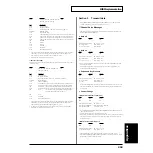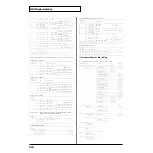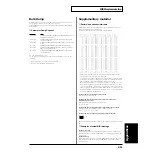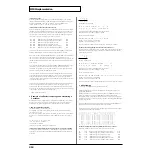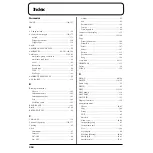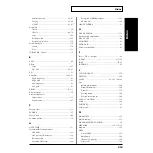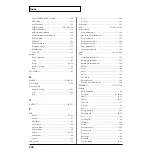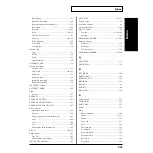
212
MIDI Implementation
<Example 3> E3 00 28
EnH is the Pitch Bend Change status, and n is the MIDI channel number. The 2nd byte
(00H=0) is the LSB and the 3rd byte (28H=40) is the MSB, but Pitch Bend Value is a signed
number in which 40 00H (= 64 x 128 + 0 = 8192) is 0, so this Pitch Bend Value is
28 00H - 40 00H = 40 x 128 + 0 - (64 x 128 + 0) = 5120 - 8192 = -3072
<Example 4> B3 64 00 65 00 06 0C 26 00 64 7F 65 7F
BnH is the Control Change status, and n is the MIDI channel number. For Control Changes,
the 2nd byte is the control number, and the 3rd byte is the value. In a case in which two or
more messages consecutive messages have the same status, MIDI has a provision called
“running status” which allows the status byte of the second and following messages to be
omitted. Thus, the above messages have the following meaning.
B3
64 00
MIDI ch.4, lower byte of RPN parameter number:
00H
(B3) 65 00
(MIDI ch.4) upper byte of RPN parameter number:
00H
(B3) 06 0C
(MIDI ch.4) upper byte of parameter value:
0CH
(B3) 26 00
(MIDI ch.4) lower byte of parameter value:
00H
(B3) 64 7F
(MIDI ch.4) lower byte of RPN parameter number:
7FH
(B3) 65 7F
(MIDI ch.4) upper byte of RPN parameter number:
7FH
In other words, the above messages specify a value of 0C 00H for RPN parameter number
00 00H on MIDI channel 4, and then set the RPN parameter number to 7F 7FH.
RPN parameter number 00 00H is Pitch Bend Sensitivity, and the MSB of the value indicates
semitone units, so a value of 0CH = 12 sets the maximum pitch bend range to +- 12
semitones (1 octave). (On GS sound sources the LSB of Pitch Bend Sensitivity is ignored, but
the LSB should be transmitted anyway (with a value of 0) so that operation will be correct
on any device.)
Once the parameter number has been specified for RPN or NRPN, all Data Entry messages
transmitted on that same channel will be valid, so after the desired value has been
transmitted, it is a good idea to set the parameter number to 7F 7FH to prevent accidents.
This is the reason for the (B3) 64 7F (B3) 65 7F at the end.
It is not desirable for performance data (such as Standard MIDI File data) to contain many
events with running status as given in <Example 4>. This is because if playback is halted
during the song and then rewound or fast-forwarded, the sequencer may not be able to
transmit the correct status, and the sound source will then misinterpret the data. Take care
to give each event its own status.
It is also necessary that the RPN or NRPN parameter number setting and the value setting
be done in the proper order. On some sequencers, events occurring in the same (or
consecutive) clock may be transmitted in an order different than the order in which they
were received. For this reason it is a good idea to slightly skew the time of each event (about
1 tick for TPQn =96, and about 5 ticks for TPQn =480).
*
TPQN: Ticks Per Quarter Note
●
Example of an Exclusive message and calculating a
Checksum
Roland Exclusive messages (RQ1, DT1) are transmitted with a checksum at the end (before
F7) to make sure that the message was correctly received. The value of the checksum is
determined by the address and data (or size) of the transmitted exclusive message.
❍
How to calculate the checksum
(hexadecimal numbers are indicated by “H”)
The checksum is a value derived by adding the address, size and checksum itself and
inverting the lower 7 bits.
Here’s an example of how the checksum is calculated. We will assume that in the exclusive
message we are transmitting, the address is aa bb cc ddH and the data or size is ee ff gg
hhH.
aa + bb + cc + dd + ee + ff + gg + hh = sum
sum / 128 = quotient... remainder
128 - remainder = checksum
(However, the checksum will be 0 if the remainder is 0.)
<Example 1> Setting Shell depth of snare drum (Trigger 3) in drum kit 1 to “DEEP2”.
According to the “Parameter address map”, the drum kit No.1 has an address of 01 00 00
00H, Trigger 3 has a offset address of 03 00H and SHELL DEPTH has a offset address of
27H. Thus,
01 00 00 00
03 00
+) 27
01 00 03 27
and “DEEP2” is a value of 02H,
F0 41 10 00 20 12 01 00 03 27 02 ?? F7
(1) (2) (3) (4) (5) address data checksum (6)
(1) Exclusive status, (2) ID number (Roland), (3) Device ID (17),
(4) Model ID (TD-8), (5) Command ID (DT1), (6) EOX
Next we calculate the checksum.
01H + 00H + 03H + 27H + 02H = 1 + 0 + 3 + 39 + 2 = 45 (sum)
45 (sum)/ 128 = 0 (quotient)... 45 (remainder)
checksum = 128 - 45 (remainder) = 83 = 53H
This means that F0 41 10 00 20 12 01 00 03 27 02 53 F7 is the message we transmit.
<Example 2> Requesting transmission of brush switch of drum kit 1.
According to the “Parameter address map,” the drum kit No.1 has an address of 01 00 00
00H, drum kit common parameter has a offset address of 00 00H and brush switch has a
offset address of 12H. Thus,
01 00 00 00
00 00
+) 12
01 00 00 12
Since Size = 00 00 00 01H,
F0 41 10 00 20 11 01 00 00 12 00 00 00 01 ?? F7
(1) (2) (3) (4) (5) address size checksum (6)
(1) Exclusive status, (2) ID number (Roland), (3) Device ID (17),
(4) Model ID (TD-8), (5) Command ID (RQ1), (6) EOX
Next we calculate the checksum.
01H + 00H + 00H + 12H + 00H + 00H +00H + 01H = 1 + 0 + 0 + 18 + 0 + 0 + 0 + 1 = 20 (sum)
10 (sum) / 128 = 0(quotient)... 20 (remainder)
checksum = 128 - 20 (remainder) = 108 = 6CH
This means that F0 41 10 00 20 11 01 00 00 12 00 00 00 01 6C F7 is the message we transmit.
●
About tuning
*
Tuning by sending RPN#1 is only possible in GM mode.
In MIDI, individual Parts are tuned by sending RPN #1 (Channel Fine Tuning) to the
appropriate MIDI channel.
In MIDI, an entire device is tuned by either sending RPN #1 to all MIDI channels being
used, or by sending a System Exclusive MASTER TUNE (address 00 0A 00 00H).
RPN #1 allows tuning to be specified in steps of approximately 0.012 cents (to be precise,
100/8192 cent). One cent is 1/100th of a semitone. System Exclusive MASTER TUNE allows
tuning in steps of 0.1 Hz.
The values of RPN #1 (Channel Fine Tuning) and System Exclusive MASTER TUNE are
added together to determine the actual pitch sounded by each Part.
Frequently used tuning values are given in the following table for your reference. Values
are in hexadecimal (decimal in parentheses).
+--------+--------+--------------+---------------------+
|Hz in A4| cent | RPN #1 | Sys.Ex. 00 0A 00 00 |
+--------+--------+--------------+---------------------+
| 445.0 | +19.56 | 4C 43 (+1603)| 00 01 02 09 (+50) |
| 444.0 | +15.67 | 4A 03 (+1283)| 00 01 01 0F (+40) |
| 443.0 | +11.76 | 47 44 (+ 964)| 00 01 01 05 (+30) |
| 442.0 | + 7.85 | 45 03 (+ 643)| 00 01 00 0B (+20) |
| 441.0 | + 3.93 | 42 42 (+ 322)| 00 01 00 01 (+10) |
| 440.0 | 0.00 | 40 00 ( 0)| 00 00 0F 07 ( 0) |
| 439.0 | - 3.94 | 3D 3D (- 323)| 00 00 0E 0D (-10) |
| 438.0 | - 7.89 | 3A 7A (- 646)| 00 00 0E 03 (-20) |
+--------+--------+--------------+---------------------+
<Example> In GM mode, set the tuning of MIDI channel 3 to A4 = 442.0 Hz
Send RPN#1 to MIDI channel 3. From the above table, the value is 45 03H.
B2
64 01
MIDI ch.3, lower byte of RPN parameter number:
01H
(B2)
65 00
(MIDI ch.3) upper byte of RPN parameter number:
00H
(B2)
06 45
(MIDI ch.3) upper byte of parameter value:
45H
(B2)
26 03
(MIDI ch.3) lower byte of parameter value:
03H
(B2)
64 7F
(MIDI ch.3) lower byte of RPN parameter number:
7FH
(B2)
65 7F
(MIDI ch.3) upper byte of RPN parameter number:
7FH
Содержание V-Drums TD-8
Страница 24: ...24 ...
Страница 25: ...25 Quick Start Quick Start ...
Страница 76: ...76 ...
Страница 77: ...77 Advanced Use Advanced Use ...
Страница 164: ...164 ...
Страница 165: ...165 Appendices Appendices ...
Страница 178: ...178 ...






